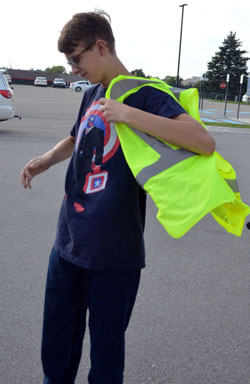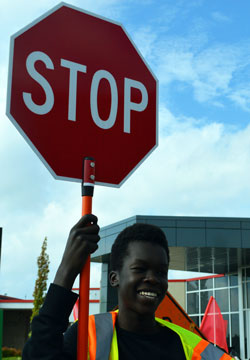While hoisting stop signs and ushering classmates through a faux work zone, East Kentwood students learned the daily duties of flaggers — the neon vest-clad road workers who help keep work zones safe.
“I can see me standing out here like, ‘Hold up! Stop!’” said sophomore Adonis Hughes as he lifted a traffic sign and held out his hand in a gesture to stop.

George Smith, employee-safety superintendent for the Kent County Road Commission, taught students how to securely set up road signs; how to be visible but safe when directing traffic, and everything else on the checklist of flagging a work zone.
About 40 students are spending two afternoons per week learning about public works and related jobs. By the end of the school year, they will have had 400 hours of instruction. The pilot course involves a partnership between the after-school ARCH program, the City of Kentwood Department of Public Works and Grand Rapids Community College. Students will earn certifications — including flagger certification — along with hands-on experience in the field.
“At the end of the year they’ve got a list of things they can show they are really excited about and they are employable right away,” said Cade Wilson, ARCH coordinator.
City of Kentwood DPW Director John Gorney said the program, similar to the GRCC Public Works Academy but geared toward high school students, weaves in two years of public works knowledge. Having those basics plus credentials is huge, he said.

A Direct Link to City Jobs
The partnership, which is a new focus of ARCH this year, links students directly with jobs in the city of Kentwood. If students complete the program, they are guaranteed a job interview. They are also learning “soft skills” like interviewing, creating a resume, and professional communication.
“They will really be ready to go to work,” said Steven Ray, a GRCC instructor who’s helping teach the course. Students will learn about power tools and machinery, earn 10-hour OSHA cards, CPR and First Aid certification, and complete one module of the National Center for Construction, Education and Research. They will also receive training on overhead crane and rigging, and playground safety.
Gorney said municipalities statewide need workers. At one time there were 100 applicants for every job, but now positions are going unfilled.
“We wanted to create a pathway for students to get into public works,” said Gorney, who is leading classes on work zone safety, basic sanitary sewer collection, winter operations, stormwater and playground safety, budgeting and building maintenance.
He’s hoping to eventually hire students. “We sometimes struggle finding seasonal staff too,” he said. “If they do well, they can come back in college each summer and then go into full time jobs.”
Sophomore Joel Riihimaa said he is interested in “a little bit of everything” about public works jobs. He plans to pursue a career in residential construction. “To actually be able to do this and get certified in it is really cool.”
Sophomore Reilly Hosteter agreed. “It interests me to be an engineer. This stuff makes me excited. It gives me hands-on experience.”
Various entry level public works positions start at between $16 to $20 per hour with benefits including health insurance, retirement and vacation, according to information from GRCC. Gorney said the City of Kentwood pays seasonal, part time workers $12 to $14 per hour, and full-time entry level workers $16 to $19.













